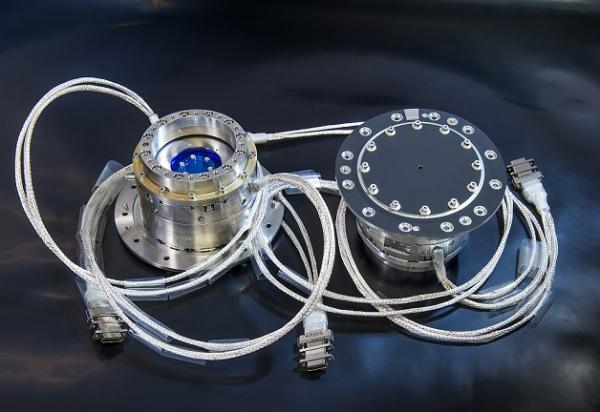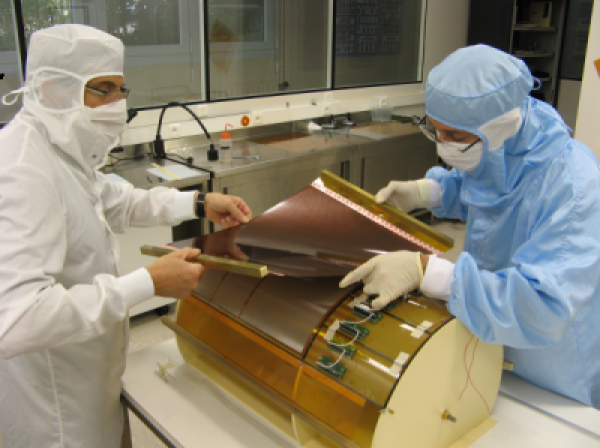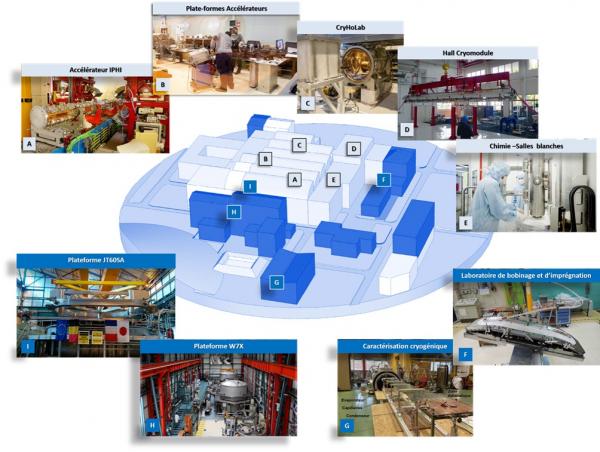The Institute's technological positioning is closely linked to the scientific programme that guides the necessary instrumental developments and to the R&D programme in the Institute's fields of expertise.
At Irfu, there are several platforms for the realization, integration, and testing of prototypes or series of detectors, to serve our various themes such as space, detectors, accelerators and cryomagnetism.

The development and construction of space instruments is one of the strengths of the astrophysics department. It relies primarily on specific engineering skills, but also on the equipment and infrastructures necessary for successfully carrying out instrument developments in compliance with the following needs:
- performance measurements on detectors in the R&D phases,
- integration and metrology of subsystems or instruments during the construction phase, in space quality assurance conditions,
- operating and performance tests on integrated components, subsystems or instruments.
Within the Astrophysics Department, these resources are formally monitored by the Space Quality and Integration Laboratory.
A new platform was created in 2018 and brings together the necessary hardware resources for cryogenic mechanisms designed for infrared astrophysical instruments.
Indeed, since the end of the 1990s, Irfu, via the Systems Engineering Department, has been involved in the design, integration and testing of cryomechanisms: VISIR project in 2004, MIRI imager on the JWST in 2019, and in the future, these mechanisms have been selected for the Euclid space mission NISP instrument, and the METIS instrument which will be installed on the E-ELT in Chile around 2024.
For subatomic physics experiments, laboratories rely on platforms that allow them to develop R&D on detectors and microelectronics, but also to integrate them, test them and measure their performance.
R&D focuses, for example, on improving the characteristics of Micromégas detectors: high flux resistance, picosecond time measurement, radiation resistance, neutron detection, high energy resolution. To meet these needs, the "MICROMEGAS FABLAB" has been developed. This workshop is used to build Micromegas detectors or MPGDs (micro patterned gas detectors). It has equipment traditionally used in the field of printed circuits and screen printing. This is a key factor in R&D for Micromegas construction processes, but also to facilitate transfer to industry.
Muonic tomography, based on Micormagas-based trajectographs, is also taking off (ScanPyramids collaboration). The Mimosa platform housed in a 500 m² building is dedicated to the construction and characterization of instruments for muon imaging, as well as a pool of muon imagers, in a building with a total surface area of 500 m².
Irfu is also pursuing developments on innovative pixel silicon detectors, low noise microelectronic circuits targeted upgrades LHC detectors.
The Synergium is the large technology platform in the Accelerators, Cryogenics and Magnetism Department covering more than 25,000 m². It is intended for the national, European and international community, for research and development in the field of particle accelerators, cryogenic systems and superconducting magnets for the purposes of fundamental research.
It contains the assembly, testing and thermal, cryogenic, mechanical, electrical and RF testing and characterisation resources needed for these cutting-edge activities.
For many years, this platform has been playing a major role in the construction of high-tech instruments for high-energy and nuclear physics.
Its activities extend to related areas such as
- fusion (IFMIF materials study installation for thermonuclear fusion and qualification of the coils for the Japanese JT-60 SA tokamak),
- the physical sciences (Iseult very high field magnetic resonance imager installed at NeuroSpin),
- or light sources (cryomodules for the XFEL source).
The Synergium can be divided into 2 main activity sectors dedicated to studies and tests for cryomagnetism and studies and tests for accelerator components, respectively. Split between these two areas is the cryogenic production equipment and the test facilities for evaluating thermo-mechanical properties, as well as the mechanical workshop.






